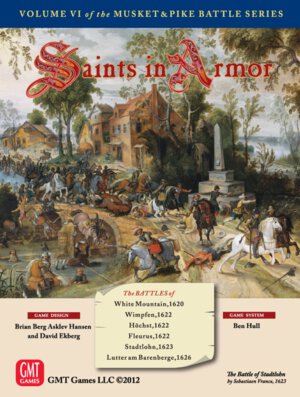Many hobbyists will recognize GMT Games for their longstanding and popular Great Battles of History (GBoH) tactical series, which was later supplemented by a more streamlined module called SimpleGBoH. This “Simple” retooling was more like a “Medium” restructuring of the system, with many players finding the module to be a more fun and easily handled incarnation of a colorful ancient warfare period that includes names like Julius Caesar and Alexander the Great.
GMT has another somewhat lesser known but equally colorful and complex (GBoH-like) stream of tactical games that cover 17th Century combat in Europe, the Musket and Pike Battle Series, or MPBS for short. Created by Ben Hull (a real-life military officer) as several desktop-published releases starting back in 1999, MPBS has steadily evolved into a very thematic line of six published titles. At the moment we have no SimpleMPBS to ease ourselves into, so the question for curious hobbyists is going to be if this series is worth investing their time and money into or not?

So where should you begin? With the earliest games being sold out (titles produced so far convey topics like the Thirty Years War, the English Civil War, and the obscure Scanian War), the clear choice is going to be Saints in Armor (SiA), which was just recently featured in an unboxing video right here on TGG. SiA has the latest version of the standard rules (6.0), six half-map battles that are smaller in size when compared to some prior scenarios, and it is the most graphically appealing package to date. Just published at the tail-end of 2012, SiA is readily available at hobby shops, online retailers, or direct from GMT.
If you want to be adventuresome, seek the out-of-print Volume 3 in the MPBS, 2005’s Under the Lily Banners (ULB), which has an illustrated example-of-play to get you started, along with an introductory scenario. You can download rules version 6.0 from GMT’s website, and everything retrofits nicely into ULB.
Let’s say you do choose to explore MPBS, here’s what you’re getting: a very rich tactical board game that requires extra time to learn and to play. Fortunately the system handles well solitaire, so you can proceed at your own pace. And when learning, here’s a piece of advice that I’ve found very helpful: don’t try to memorize the rules! The very best way to grasp MPBS is not by committing the rules to memory – the many nuances will likely eventually perplex you (they did me) – but instead familiarize yourself with the core mechanics like orders, movement, formations, reaction, fire, close combat, and morale, then punch out the pieces and maneuver them around on the map. You’ll definitely be referring to the rules on a continual basis, but a whole new world of wargaming should open up to you, and a new found appreciation for the designer’s unique vision can be gained. There are a lot of markers used during play, which can be perceived as being somewhat fiddly. I however view the markers as a necessary byproduct of the system’s authenticity. Indeed, I can hardly think of any other line of games that imparts such a tremendous historical feel any better than MPBS. Just be aware that such a feel doesn’t come free.

The play aid for MPBS is a full four page foldout that contains many charts and helpful notes, and is essential to have readily available at your side when sitting down to play. Also, if you’re more inclined to push buttons than to push pieces, computer VASSAL modules are available online for free download.
I really admire the Musket and Pike Battle Series, with the caveat that I haven’t played it as often as I would have liked. The system can be a harsh mistress because it demands your absolute full attention. But MPBS can also be very rewarding, creating thrilling sessions that embed themselves in your memory while a plethora of other less-intensive games just fade away. Charging cavalry exchanging pistol shots, a double-hex infantry unit crashing into your line with its pikes, or cumbersome field artillery blasting away to break-up an enemy formation, it’s all here. Indeed, one can almost smell the acrid odor of gunpowder when playing MPBS; it really is that remarkable of a simulation.
While individuals like Gustavus Adolphus of Sweden (the so-called “Lion of the North”) or the enigmatic Catholic commander Albrecht von Wallenstein may not exactly be household names (like Caesar or Alexander), they are renowned historical figures who each conducted their own sweeping military campaigns. The MPBS system showcases those particular campaigns (and so much more) in a time-tested manner – the more you put into it, the more you get out of it. MPBS is truly a fascinating table-top journey for those hardy enough to withstand the rigors and challenges that it has to offer.
- A Brief Overview of GMT’s Musket and Pike Battle Series - Jan 26, 2013















